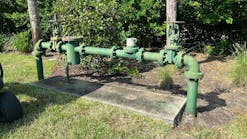New York District Employees Determined to Rebuild Caven Point Better Than Ever
Since its inception, the US Army Corps of Engineers (USACE) has prided itself on being an organization that responds to emergencies in a timely, efficient manner. This is true across the corps, whether it be at the division or district level. One of the more recent examples is the New York District’s response when Hurricane Sandy caused severe damage to the district’s Caven Point Marine Terminal in October 2012.
Caven Point is home to the district’s fleet of working vessels and several field offices. Its nearly 100 employees play key roles in missions such as drift collection, hydrographic surveys, and active construction projects tied to harbor deepening, among others. During Sandy, the storm surge caused severe damage, inundating the facility with 5 feet of sea water and compromising the main building and most equipment inside.
Taking Stock
Once the storm moved on, Tom Creamer, chief, Operations Division, began working with his staff to assess the damage, and some things became abundantly clear: First and foremost, Caven Point is more than a workplace; many view it as a second home.
“When I started taking calls from the people who worked there, I knew something was terribly wrong,” explains Creamer. “The people at Caven Point are a resilient bunch and it takes a lot to get them down.”
Arriving onsite, he found the “inside of the building looked like a washing machine,” with floating debris strewn about. There were also ruptured gas lines, small fires, and debris found as far as a mile away, carried by the powerful storm surge. Despite the devastation, employees wasted no time returning to work under very difficult circumstances.
“I’m very proud of the honor and commitment they [employees] displayed in putting aside personal challenges related to this storm in order to get Caven Point back up and running,” says Creamer. “It was amazing.”
Creamer also went to work, acquiring resources for recovery efforts, including Navy Seabees, Army divers, and a Corps of Engineers’ Deployable Tactical Operations System Emergency Command Vehicle, which served as a command hub for managing the recovery.
Managing the Recovery
Acquiring resources was an important first step. Now they had to be deployed in a complex situation. That task was assigned to John Tavolaro, deputy chief, Operations. Speaking about the challenges of managing the recovery effort, Tavolaro notes, “I’m the project manager and customer all rolled into one.”
The day after Sandy, he says, employees were “pretty much in shock,” but he was impressed with their resiliency. Despite losing nearly everything—paper files, computers, printers, plotters, and personal items—staff immediately began working from makeshift quarters aboard vessels and at home, and logging extra hours on drift-collection and survey vessels helping reopen New York Harbor, which was closed for five days after the storm.
Assisted by Anthony Lauria, heavy mobile equipment supervisor, and Walter Scott, chief, Physical Support Branch, Tavolaro was at the forefront leading employees as hands-on recovery manager. Initial tasks included ensuring survey and drift-collection vessels remained operational, acquiring trailers and furniture for temporary office space so employees could work more efficiently, supervising Navy Seabees stabilizing the main building with nearly 8 feet of boarding on each side, and supervising Army divers assessing the structural integrity of piers and bulkheads and making repairs as needed. Initial recovery and stabilization took nearly six weeks. Tavolaro also provided oversight for Caven Point’s three offices—Physical Support Branch, Survey Section, and Metro Construction. He ensured there were generators for electricity, heat, lighting, and computers, and the replacement of survey and shop equipment lost in the storm.
Dedicated, Resilient Employees
Lauria says he was completely unprepared for what he saw when he arrived at Caven Point after the storm. He spoke of personal losses, including an extensive photo library marking employee milestones. His office gone, he went to Fort Hamilton in Brooklyn, obtaining a desk and computer and requesting equipment and supplies for employees. He notes, “It wasn’t easy getting back on our feet and there were a lot of challenges, but we managed to get it done.”
Francis Postiglione, chief, Survey Section, led 32 employees during this difficult time, and his survey boats were crucial to reopening New York Harbor. When storm predictions worsened, he ensured sensitive equipment—computers and personnel files—were stored as high as possible, 25 to 30 feet off the ground in the warehouse. This proved invaluable.
Returning afterward, he says, “You couldn’t tell there was an office there.” Thankfully, equipment and information remained intact, allowing staff to quickly utilize temporary workstations set up in the Corps of Engineers’ Deployable Tactical Operations System Emergency Command and Control Vehicle.
John Mraz, deputy chief, Survey Section, monitored the storm and potential effects through computer models. He remained onsite as long as possible, and then monitored Sandy from home. Upon his return, he says, “There was nothing left in the Survey Section.” He was able to retrieve an inventory list and return to work.
William Lyness, marine superintendent, who worked closely with staff operating vessels, says, “This was a very emotional time for our people, but I’m very proud of the way they responded to the challenges Sandy presented. When it was time to get to work clearing the harbor of debris so it could be reopened, the men and women responsible for manning our vessels did not miss a single beat.”
Walter Scott, onsite manager at Caven Point, also expressed dismay at the extent of damage, but he’s committed to doing everything he can to ensure the terminal’s reconstruction will result in an improved, more resilient facility for employees. He notes, “New York District is making an investment in New York Harbor and its people.”
Restoration Plans
The decision to construct a replacement main building came about after North Atlantic Division leadership asked for an assessment of how best to restore the terminal. A team led by Richard Thorsen, NAD navigation program manager, and guided by Tavolaro, evaluated a range of solutions, considering cost, work processes, and personnel. After an in-depth review, a June 2013 report recommended Caven Point be rebuilt to provide the same functions and consolidate personnel into one building. Additional recommendations were incorporating features to reduce operating costs, improving operational efficiencies and functionality, bringing the facility up to current standards, introducing more environmentally friendly features, and hardening the facility against future flooding.
Building Overview
The new structure is designed as a two-story, 47,000 square-foot, state-of-the-art flood-resistant building. Construction began in fall 2014 and is scheduled to finish in fall 2016. The reconstruction is 100% funded by the Disaster Relief Appropriations Act of 2013 (PL 113-2), authorizing the Corps of Engineers to restore previously constructed projects severely impacted by Sandy. On September 30, 2014, a contract for nearly $43 million was awarded to J. Kokolakis Contracting Inc., of Bohemia, NY.
Administration
Nearly 18,000 square feet of replacement space houses the offices of the Physical Support Branch, Survey Section, and Construction Division, as well as an expansive training room with temporary seating for 50 students. This part of the replacement building sits atop reinforced concrete columns elevating the floor 13 feet aboveground. Should the terminal flood again, water will flow underneath and around—instead of against—the building. A two-story glass window provides panoramic views of the New York and New Jersey Harbor, outfitted with blast-resistant glass exceeding all hurricane-resistance requirements. The training area doubles as an emergency operations center should 26 Federal Plaza (district headquarters) become inaccessible.
Warehouse and Maintenance
This portion of the facility includes the machine shop, offices, locker rooms, generator room, mechanical room, electrical room, and water-quality and soil labs, which will be replaced in the new building. The 16,000-square-foot area sits 4 feet above ground level with an ADA-compliant elevator connecting with administration. Lastly, the maintenance area provides approximately 6,000 square feet to service district vessels. Other facility improvements include a new boathouse accommodating eight trailer-based survey boats, a boat ramp to directly launch trailer vessels, and replacing all concrete–approximately 75,000 square feet. The facility also includes solar thermal panels supplying approximately 30% of hot water needs, a 20-kW photovoltaic panel system, and a 10-kW wind turbine system.
Flood-Resistant Design
Matt Emigholz, project engineer, leads a 20-member design team meeting specific construction criteria. It hasn’t been easy; he cites challenges in building a flood-resistant structure on the waterfront. First and foremost, flood-elevation: keeping critical infrastructure and equipment above the floor while maintaining productive workspace. This means power cables will drop down from the ceiling, and HVAC, mechanical, and electrical equipment will be elevated 10 to 13 feet above the floor. Other challenges include working on a small parcel of land, a bulkhead requiring 30 or more feet of setback clearance, and scheduling construction around terminal operations running at all times These constraints add approximately six months’ construction time.
The interior presents other challenges, as each section requires a unique design. “It’s really three buildings,” notes Emigholz, each area with intricate configurations to reduce flood risk and storm damage. One common element is a reinforced concrete wall several feet thick lining the base of the structure to withstand water pressure and waves pounding on it.
Emigholz also speaks about enthusiasm among teammates, noting team members have taken pride working on a major project critical to operations in New York and New Jersey Harbor. He describes it as a “legacy project,” a rare opportunity to take part in something special, considering the Port of New York and New Jersey is the largest on the East Coast, providing nearly 270,000 direct and indirect jobs and $11.2 billion in personal income.
High Building Standards
This project is designed to LEED (Leadership in Energy and Environmental Design) Silver requirements. LEED is a nationally recognized benchmark for the design, construction, and operation of high-performance green buildings. LEED-certified buildings often cost less to operate–significantly reducing energy and water costs–and are less harmful to the environment. The goal is a 30% savings on energy and water.
LEED uses a points rating system. Projects earn points for minimizing impact on ecosystems and water resources, promoting smarter use of water and better energy performance, using sustainable building materials, achieving better indoor air quality, and access to daylight. Points for new construction include four levels: 40-49 (Certified), 50-59 (Silver), 60-79 (Gold), and 80+ (Platinum). The new building, rating Silver, meets exemplary standards.
Moving Forward
Fall 2014 marks two years since Sandy dealt a major blow to Caven Point, but daily operations continue relatively uninterrupted. Much of this can be attributed to employees’ effort and determination creating a framework—and mindset—for reconstructing Caven Point into a modern, flood-resistant facility better equipped to withstand severe weather and support corps’ operations in New York- and New Jersey-area waters. This replacement building will play a key role helping the district continue to serve nearly 20 million people in its area of responsibility with quality projects and services.






